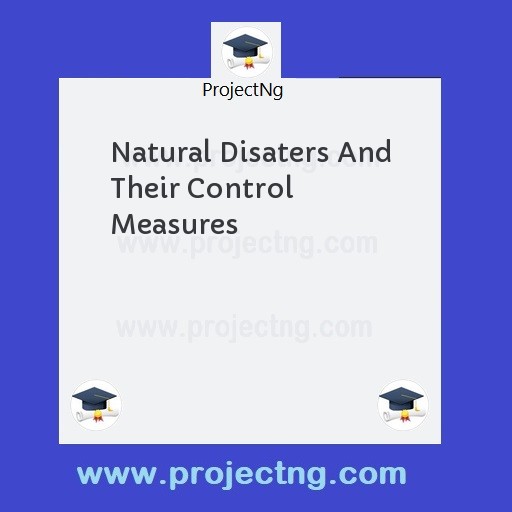Natural Disaters And Their Control Measures
Science Lab Technology Project Topics
Get the Complete Project Materials Now! »
NATURAL DISATERS AND THEIR CONTROL
MEASURES
ABSTRACT
A natural disaster is a major adverse event resulting from natural processes, of the earth; examples include floods, volcanic eruptions, earth quakes, tsunamis, and other geologic process. Natural disasters are caused by nature and there is nothing one can do to prevent them from happening. There are many different types of natural disaster which are grouped into hydrological disaster, metrological, Health type of natural disaster and space types of natural disaster. Natural disasters have impacts, which can be economical, health, environmental, psychological and physical impacts. All these impacts or effects can be direct (in the case of injury/Death) an indirect (when it only involves properties and environmental changes).
TABLE OF CONTENTS
Cover page - - - - - -- - -- - - -- -- - - - - -- -- - - - - - -- i
Dedication - - -- - - - - - - - - - - - - - - - -- - -- - - - - - - - - ii
Table of contents- - -- - - - - - - - - - - - - - - - - - - -- - - iii
Abstract - - -- - - - - - - - - -- - - - - - - - - - - -- - -- - -- vi
CHAPTER ONE
1.0 Introduction - - - -- - - - - - - - - - - - - - - - -- - -- - -1
CHAPTER TWO
2.0 Causes of Natural Disaster -- - - --- --- - - - - - - - - -4
2.1 Types of Natural Disaster -- - - - - - - - - -- - - - -- -7
2.1.1 Hydrological Types of Natural Disaster - - -- - -- -7
2.1.2 Meteorological Types of Natural Disaster - -- - - - -9
2.2 Health Types of Natural Disaster -- - - - - - - -- - - 13
2.3 Space Types of Natural Disaster - - - - - -- - -- -- 13
CHAPTER THREE
3.0 Impact of Natural Disaster -- - - - - - - - - - - -- - - 16
3.1 Economic Impact of Natural Disaster -- -- - - --- - 17
3.2 Health Impact of Natural Disaster - -- - - -- - -- - 19
3.3 Environmental Impact -- - - - - - - - - - -- - -- - 20
CHAPTER FOUR
4.0 Psychological Impact of Natural Disaster - - - - - - 22
4.1 Physical Impact of Natural Disaster -- -- - - - - - - 24
CHAPTER FIVE
5.0 Conclusion and Recommendation ---- - - - - - - - - -26
5.1 Conclusion- - - - - - - - -- - - --- -- -- -- - - - -- -- -- 26
5.2 Recommendation - - -- - - - - - - - - - - - - - - - -- -27
Reference -- -- -- - -- - - - --- - --- -- - -- - - - - -- -- - - 29
CHAPTER ONE
1.0 INTRODUCTION
A natural disaster is a major adverse event resulting from natural processes, of the earth; examples include floods, volcanic eruptions, earth quakes, tsunamis, and other geologic processes. A natural disaster can cause loss of life or property damage and typically leaves some economic damage in its wake, the severity of which depends on the affected population’s resilience or ability to recover (Pesos, 2008). An adverse event will not rise to the level of a disaster if it occurs in an area without vulnerable population. In a vulnerable area, however such as san-Francisco, an earth quake can have disastrous consequences and leaves lasting –damage –requiring years to repair-(Alexander, 2002).
In 2012, there were 905 natural catastrophes worldwide, 93% of which were weather–related, disasters. Overall costs were billions of dollars. 2012 was a moderate year. 45% were meteorological (storms), 36% were-hydrological (floods), 12% were climatological (heat waves, cold waves, droughts, wildfires) and 7% where geophysical event (earth quakes and volcanic eruptions). Between 1980 and 2011 geophysical events accounted for 14% of all natural catastrophes (Goshua, 2008).
The definition of natural disaster impact (ND1) can change according to both the aim of the study and the scientist assessing it. Economically, natural disaster can act as a barrier to development, increasing poverty and having a small but significant negative effect on economic growth (Davies, 2013). This effect can reform a society to the level of human development it had achieved two years prior to the disaster. It can also lead to indirect societal effects such as decrease in productivity in people affected by disaster can influence economic growth (Bankoff, 2003). Human capital can be directly affected by these disasters through death or injury and in indirectly affected when damage affect facility such as school, leading to the reduction in human capital. All these effects can be mild and transitory or lead to post traumatic stress disorder (PGSD) leading to the negative effect of mental state of the victim (Gibbons, 2010).
Be the First to Share On Social

Enjoying our content?
Don't miss out on new videos! Subscribe to our YouTube channel for more awesome content.
Subscribe Now!













